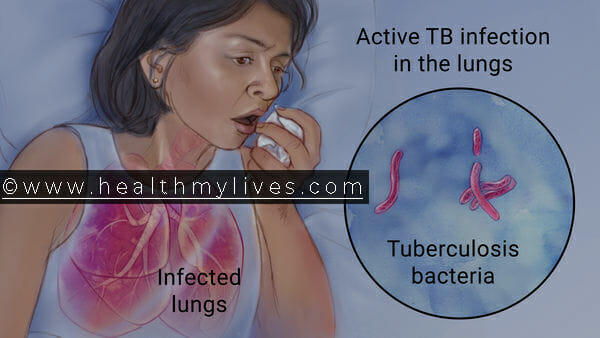Questo post è stato aggiornato di recente il 25 luglio, 2023
Panoramica:-
Tubercolosi(TBC) è una malattia batterica cronica altamente trasmissibile che spesso si riscontra in persone che vivono in luoghi bui, sporchi e congestionati. È una malattia infettiva che colpisce principalmente i polmoni ma può colpire qualsiasi tessuto del corpo( tranne i capelli, chiodo, e smalto dei denti). Può anche essere conosciuta come la malattia di Koch o il re della febbre o peste bianca. Generalmente, la tubercolosi si è verificata nei polmoni chiamata tubercolosi polmonare mentre la tubercolosi si è verificata in altre parti dell'organo è chiamata tubercolosi extrapolmonare. Può moltiplicarsi rapidamente in un corpo e distruggere i tessuti. però, i polmoni sono il sito preferito di infezione dove si forma la piccola malattia, la condizione chiamata tubercolosi polmonare. Circa, un terzo(1/3) del mondo è infetto da nove milioni di nuovi casi di tubercolosi attiva e 1.7 milioni di morti ogni anno. In Nepal, è generalmente noto come “Kshaya Rog.”
Secondo l'ultimo studio del NEPAL, 80,000-900,000 le persone sono infette su cui fino a 4000 nuovi casi ogni anno.
avvenimento
È una malattia ampiamente diffusa riscontrata in quasi tutte le comunità del mondo. Nel NEPAL e negli Stati Uniti, è più comune nelle aree non urbane. La gravità dell'infezione risulta evidente dal fatto che circa 50,000 ogni anno vengono segnalati nuovi casi. I decessi annuali dovuti alla tubercolosi sono compresi tra 15,000-16,500.
causale Organismo
L'agente eziologico della tubercolosi è il Mycobacterium tuberculosis. È una piccola forma a bastoncino, non capsulato, non sporulante, e batterio bacillo non mobile. È un bacillo acido-resistente comunemente noto come AFB in forma abbreviata.
Altre specie
un') M. bovis – Infetta il bestiame. Creme spalmabili a base di latte crudo/carne.
B) M. africano.
C) M. avium/complesso intracellulare(MAC): Nei pazienti affetti da AIDS.
Serbatoio e fonte di infezione
Mycobacterium tuberculosis è per lo più limitato in una persona infetta, ma in alcuni casi, anche i bovini infetti fungono da serbatoio. La fonte della contaminazione nella tubercolosi polmonare sono le secrezioni respiratorie; e il latte di mucche malate. Tubercolosi extrapolmonare( questo è diverso dalla tubercolosi polmonare) di solito non è responsabile dell'infezione di altri.
Modalità di trasmissione
- Infezione da goccioline( 1 tosse→ ~3000 nuclei di goccioline).
- La tubercolosi bovina può diffondersi attraverso il consumo di latte non pastorizzato o carne cruda.
Questa malattia si diffonde principalmente da gola e secrezioni nasali di una persona affetta da uno stadio attivo della malattia. Il contagio può essere diretto o indiretto(germi presenti nell'aria e nelle goccioline).
Periodo di incubazione
Il periodo di incubazione della tubercolosi è abbastanza variabile, che vanno da alcune settimane ad anni.
Tipi di tubercolosi
UN) TBC primaria: Infezione in un individuo precedentemente non infetto o non immunizzato.
B) TBC secondaria: Infezione in un precedentemente sensibilizzato( mediante infezione o immunizzazione) ospite.
Basato sull'organo coinvolto
un') TBC polmonare
- TBC dei polmoni- Sedi di infezione più frequenti.
- Colpisce comunemente la parte inferiore del lobo superiore e la parte superiore di quello inferiore (Primario) o apici dei polmoni(Secondario).
B) TBC extrapolmonare
- TBC di tessuti diversi dai polmoni.
- Si verifica comunemente per diffusione ematogena dal focolaio polmonare. Può verificarsi a causa di un'infezione primaria dell'organo stesso.(per esempio. TBC intestinale)
Organi comuni coinvolti
→ Linfonodi: Linfoadenite tubercolare.
→ Meningi: Tubercolosi meningite.
→ Reni: TBC renale.
→ Ghiandole surrenali.
→ Ossa: Osteomielite tubercolare.
→ Vertebre: La spina dorsale di Pott.
→ Intestino: Intestinale, TBC.
- La tubercolosi militare deriva dalla diffusione capillare dell'organismo attraverso la circolazione.
- La tubercolosi è rara nei capelli e nelle unghie.
Sintomi
Nelle persone infette, i batteri rilasciano una sostanza tossica chiamata tubercolina, che produce diversi disturbi nel corpo. I sintomi possono variare a seconda degli organi. Alcuni di essi sono riportati di seguito:
Tubercolosi polmonare(TBC polmonare)
- La tosse è il primo segno che si può osservare in una persona infetta.
- Febbre leggera e costante.
- Si può vedere espettorato contenente sangue.
- Dopo alcuni giorni di infezione, il tuo peso corporeo verrà ridotto drasticamente.
- Dolore al petto.
- Perdita di appetito.
- Perdita di appetito.
- Il tuo corpo si indebolirà gradualmente.
Tubercolosi extrapolmonare
- Dolore nei tessuti colpiti che dura da tre a sei mesi.
Diagnosi
- La diagnosi di tubercolosi è confermata dal test della tubercolina o di Mantoux.
- Radiografia del torace.
- Espettorato positivo.
- Analisi gastrica, eccetera.
Prevenzioni della tubercolosi
Le prevenzioni contro questa malattia includono:
- Educazione di massa sul pericolo della tubercolosi.
- Evitare di fumare. Se non sei un fumatore, quindi non avviarlo mai.
- Identificazione e trattamento adeguato dei pazienti affetti da tubercolosi.
- Immunizzazione di persone non infette mediante BCG( Bacillo Calmette Guerin) vaccino che conferisce certezza, anche se una protezione parziale.
- Garantire una fornitura di latte sicura ed eliminare la tubercolosi tra i bovini da latte.
- Miglioramento delle misure igieniche personali di vita e di alimentazione.
- Riabilitazione.
Trattamenti della tubercolosi
Varie organizzazioni governative e private(ONG) stanno lavorando per l’eradicazione di questa malattia altamente contagiosa in diversi paesi come il Nepal e gli Stati Uniti. Questa malattia richiede un trattamento migliore nelle fasi iniziali per ottenere risultati migliori. Per controllare questa grave malattia, HMG Nepal ha lanciato il programma DOT (Breve corso del trattamento osservato direttamente), sviluppato da IUATLD ( Unione internazionale contro la tubercolosi e le malattie polmonari). Il programma DOT prevede principalmente diagnosi di buona qualità e chemioterapia di breve durata somministrata sotto monitoraggio sistematico e supervisione diretta.
I pazienti affetti da tubercolosi possono essere trattati con streptomicina, NON (Acido para-aminosalicilico), Isoniazide, Rafampicina, eccetera.
Alcuni fatti sulla tubercolosi
→ Ogni 24 marzo si celebra la Giornata mondiale della tubercolosi.
→ I centri SAARC TB e HIV/AIDS si trovano in Nepal (RITORNO, Bhaktapur).
→ La tubercolosi è l'infezione opportunistica più comune nei pazienti affetti da AIDS.





